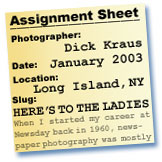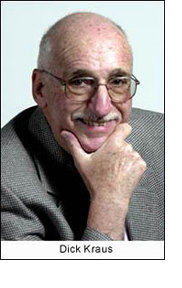 |
|
|
|
|
|
HERE'S
TO THE LADIES This issue of The Digital Journalist is devoted to women in Photojournalism. As the editor of Assignment Sheet, I do wish that there were more women contributing to this feature. The only female who is a regular contributor is my friend, Susan Markisz. I love the way she writes and she brings a whole other perspective to the journals usually read on this site. In addition to being a wonderful writer and story teller, she is an excellent photographer. All of us in this profession manage to accrue some great stories over time, and that is what Assignment Sheet is all about; telling the stories that we live through in the pursuit of our livelihood. Let me spend a brief moment here, making a pitch to any female photographers who might be reading this. If you have any interesting stories or something to say, please contact me. My e-mail address is listed below this article. Now, HERE'S TO THE LADIES. When I started my career at Newsday back in 1960, newspaper photography was mostly an all boy's club. There were a few women photographers scattered around the country, but they were few and far between. And, they were usually relegated to shooting women's page stuff. This wasn't unusual. When I was in the Navy, a few years earlier, female enlistees weren't called sailors. They were WAVES and they worked as secretaries or in the medical fields. They weren't Gunner's Mates or Bosun's Mates. Now women in the Navy are sailors and they command ships, fly planes and are Bosuns and Gunners and Mechanics and ElectronicsTechs. And women in all services are trained in combat roles. Times have changed. Newsday had had a female photographer before I joined the staff, but she was gone by the time I got there. In 1960, the entire staff of photographers, photo editors and darkroom personnel were male. It was to remain that way for several more years. During that "boy's club" period, the Photo Department took on the atmosphere of a men's club; or worse, a men's locker room. No one had any need to watch one's language and the jokes that were told while waiting for our film to dry would peel the paint off the walls. Some years after I was hired, I was working one Sunday and the boss was also on duty. He liked to spend most of Sunday morning in the darkroom before the darkroom crew came on duty, printing the photo stories that he dearly loved to produce. He told me that he was expecting an applicant for a photo position to come in for an interview and asked me to call him out of the darkroom when she arrived. "She...???" I finished typing my captions and was kneeling on the floor, looking for something in my locker when I heard a voice call, "Hello?" I peered around the locker and all I could see was this great pair of legs that stopped at the shortest mini-skirt I have ever seen. I couldn't see the rest of her at that point. I said, "Just a minute." And I went back to the darkroom and told the boss, "I don't care if she can shoot, or not. Just hire her." OK. It's obvious that I am a sexist pig. But, it turned out that she was a great photographer and one of the nicest people that I have ever met. She was the first female photographer on the staff during my tenure at the paper. It did give us something to talk about. We heard from photographers from other papers that it was fun to shoot high school basketball with her. She always wore those incredibly short mini's and because the photographers were required to squat down on the sidelines while shooting, we heard stories of players crashing into walls because they were enjoying the scenery instead of watching what they were doing. It used to drive the coaches and the referees crazy. But, there were more serious considerations involved in having women on the staff. A few years later, I found myself putting in a couple of years as Night Photo Editor and this gal was on my shift. This was the 60's and 70's and we were up to our necks in civil rights and anti war demonstrations and many of them erupted into violence, with injury and loss of life a commonplace occurrence. I only had three or four photographers working the night shift and one of them was this lady. Now, I am a sexist pig, but I do have concerns about the safety of my staff, especially the "weaker sex". When we sign on as staff photographers for a paper, it is implicit that there will be occasions where we will find ourselves in perilous situations. It's part of the territory. When I was on the street as a shooter, I had covered the aforementioned demonstrations and found myself dodging stones, bricks, cement blocks and even bullets. Now I was sending other photographers into harms way. It caused me enough anguish to send the men on my shift, but I had trouble sending this girl. I discussed this with my department head. He told me that my feelings were understandable, but, I had to treat her like any other photographer. It wasn't fair to the others if I kept her safe all the time, and sent them into the fracas, night after night. He was right, of course. But, the first time that I put her into the rotation, I counseled her on what to watch for and not to take any unnecessary risks. She did just fine. Over the years we added more women to our staff, as photographers, darkroom techs and as editors. It was no longer a "good ol' boy's club." Other papers were doing the same thing. Once, I put my foot in my mouth (well, I've done that more than once) when I acted very boorishly to a young female photographer from the NY Post. She had just been hired and her being selected for the job annoyed me. There was another young photographer who had more experience and who happened to be a male, who had applied for the position. He was a very likeable person and a good shooter. She was just out of school and had no experience and it annoyed me that she had been selected over him. I felt that the choice was made because the head of the Post's Photo Department was a woman. So, on this particular day, I was standing outside of the police line at a fire that had killed a couple of volunteer firemen. This young woman, about whom I am writing, took a position next to me. "Hi," she says. "What's the exposure?" An innocent question and one that we have all asked rather than dragging out our own exposure meter and taking a reading. (This was in the days before built-in meters.) The bristles went up on the nape of my neck. I was still rankled at her being hired instead of the young man. I had known this young lady for a few years. When she was a high school student, she used to attend the Press Photographers of Long Island meetings with her school camera club mentor. I stared at her for a moment. "If you consider yourself a professional now, you would take your own exposure reading instead of bothering others." Jeez! I wish that I hadn't said that. It was over 35 years ago, and in spite of our long association which has grown into a treasured friendship, she has never really forgiven me for those words. And, I don't blame her. I haven't forgiven myself. Life goes on. Women are an integral part of news photography. I have learned to soften my sexist attitudes and I do believe that towards the end of my career, I have accepted women in photojournalism as partners in a noble profession. I had no trouble working with my last Photo Editor, who was a young female. I respected her news judgment and her ability to select my images. HERE'S TO THE LADIES!
Dick Kraus |
